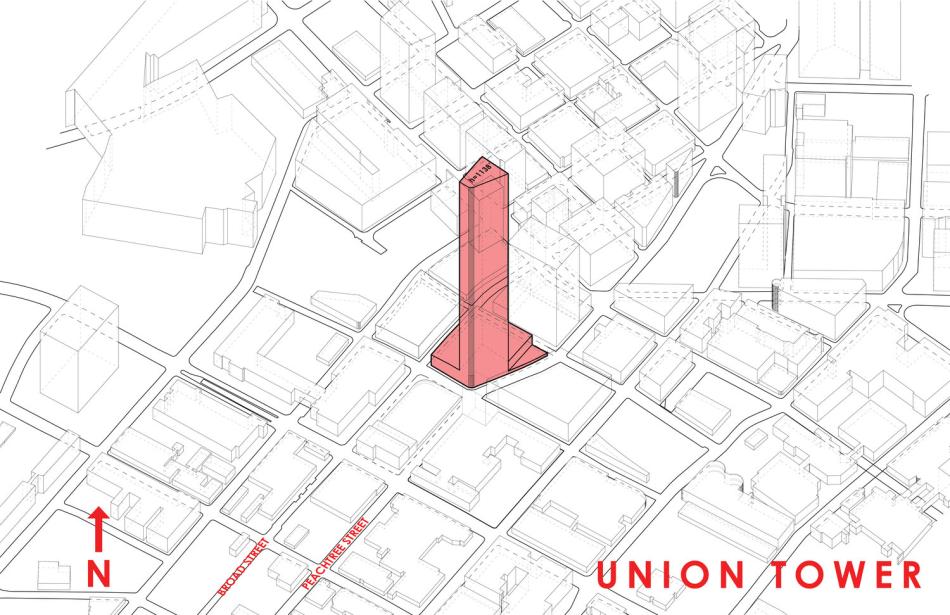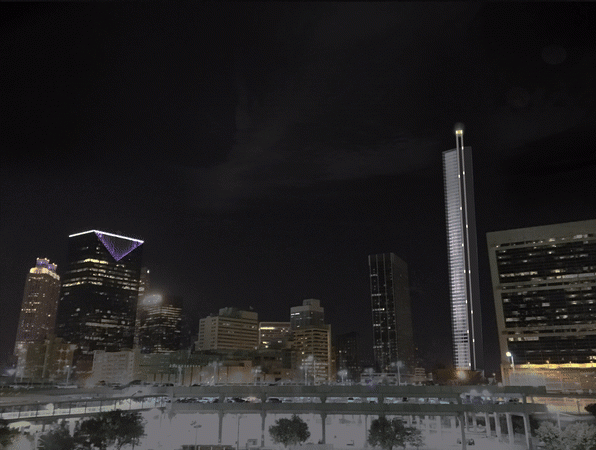The skies over intown Atlanta are filled with empty space where big dreams were hatched but never grew up. Think of the titanic, 11-block GLG Park Plaza project—or more recently, Midtown’s infamous No2 Opus Place.
A lesser-known but equally impressive whopper of a proposal in the annals of Atlanta history was called Union Tower, which would have lorded over downtown as the tallest building in the Southeast.
But unlike the aforementioned examples, the architect believes the concept is still viable downtown, pending some monumental puzzle pieces falling into place.
The Union Tower concept called/calls for a 1,138-foot-tall skyscraper standing over and breaking up the above-ground massing of MARTA’s Five Points station, allowing North and South Broad streets to reconnect at the tower’s base, as they once were before the station divided them. It would top out 115 feet taller than Bank of America Plaza, which has held the title of Atlanta’s tallest high-rise for more than three decades.
In terms of location, the logic went that the birthplace of Atlanta naturally deserved to lay claim to its tallest building.
Union Tower was originally the brainchild of two Georgia Tech students studying for their master of architecture degrees, Pavan Iyer and Jennifer Lee Johnson, as part of the school’s Portman Prize annual competition between studio classes. In 2017, the program’s focus was on South Downtown as prospects of redevelopment started heating up.
“As part of the project, we went out to the site and talked to random people on the street to ask if they could draw a map of South Downtown,” says Iyer, who would go on to found eightvillage, an Atlanta-based architecture, urban design, and ecology consultancy firm. “Just about everyone's drawings acknowledged that Broad Street is a tale of two sides in every way.”
 The tower concept's placement next to a reconnected Broad Street, over today's Five Points station. eightvillage
The tower concept's placement next to a reconnected Broad Street, over today's Five Points station. eightvillage
Thus, Union Tower’s key objective of reconnecting the street grid was hatched. Another theme of the project would nod to Atlanta’s deep movie history and status as a new powerhouse in the TV/film industry; plans called for weaving film spaces—production studios and post-production offices, for instance—alongside an unspecified number of residential units. The name itself paid homage to Atlanta’s Union Station, which was razed a block from Five Points in the early 1970s.
“Our original thesis was to create a tower that celebrated film as an homage [to] Atlanta’s film history with a street-level replacement of the demolished Lowe's theater,” Iyer says. “We also had explored grocery stores [and other uses], given that there are multiple ways to do access and loading for the site.”
 How the Union Tower building could have appeared from elevated MARTA tracks near Grant Park and Sweet Auburn. eightvillage
How the Union Tower building could have appeared from elevated MARTA tracks near Grant Park and Sweet Auburn. eightvillage
Other aspects called for Union Cinemas, Atlanta’s “premiere downtown theater,” at street level alongside Blade Runner-style LED signs, large monitors, and “back-projected textile skin” that showcased local art and culture around base levels.
The wildest element would have harkened to Broad Street’s history as an epicenter of action, with its restaurants, department stores, and even carnival rides and games. Drawing on the kitsch of a carnival and Willy Wonka’s glass elevator, Union Tower’s “Wonka-Vator” would have been a cyclical elevator system that “takes patrons in a Ferris-wheel like ride in a glass elevator up and over the top of the building, allowing for full views of the city,” per the original pitch.
Iyer says he spent an additional year or so trying to pitch the tower concept after grad school, and that he hasn’t given up hope since. “I do think the project is still possible, if MARTA could be open to reconnecting the [street] grid,” he says. (Plans for Five Points station’s overhaul do call for reconnected streets, but the tower’s base would certainly interfere with MARTA’s renovation goals.)
Union Tower clearly didn’t materialize (yet), but Iyer says the big idea did lead to positive developments. It opened the door to him meeting with Newport US, the Germany-based company that would come to own many blocks in South Downtown, and South Broad Street arts organizations. That allowed Iyer to pitch the idea and get the ball rolling, he says, on having well-attended Atlanta Streets Alive programs extended to the area—a tradition that continues today.
“I was as passionate about getting North and South Broad [streets] reconnected as I was trying to get a mixed-use vision going for Five Points,” Iyer says. “I actually was supposed to get a chance to pitch it to MARTA, but I never got to.”
Find more Union Tower site context and visuals—all depicting what could have been, in another reality—in the gallery above.
...
Follow us on social media:
Twitter / Facebook/and now: Instagram
• Downtown news, discussion (Urbanize Atlanta)










